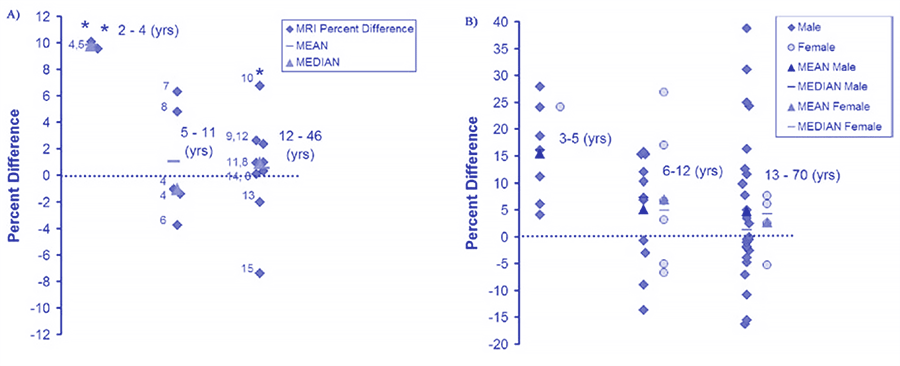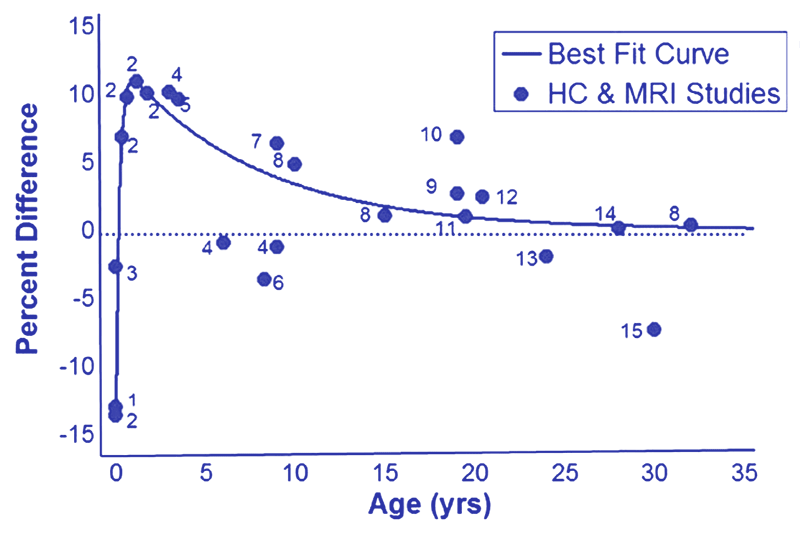In the previous part, we looked at the head circumference of autistic children, which was found to be increased on average.
But an enlarged head is not just an outwardly physical feature, nor is the increase in head size due to autistic people having thicker skulls. Everything you heard about the alleged similarities between autistic people and the pachycephalosaurus is a myth!
No, the enlarged head tends to come with a larger brain. Unlike, indeed, the brain of the pachycephalosaurus, which is quite small.
Brain enlargement
A study from 2001 found that 90% of autistic boys aged 2–4 years had a brain volume larger than normal, whereas only one non-autistic boy exceeded the autism mean.[1]Unusual brain growth patterns in early life in patients with autistic disorder: an MRI study (Courchesne et al., 2001)
37% of the boys met the criteria for developmental megalencephaly, which is a growth development disorder in which the brain is abnormally large.[2]Unusual brain growth patterns in early life in patients with autistic disorder: an MRI study (Courchesne et al., 2001)
Heavy brains
A meta-analysis from 2005 that looked at age-related changes in autism brain weights found that brain weight was 15% greater in autistic boys 3–5 years of age compared to controls. The average brain weight was found to be 1,451 g versus 1,259 g.[3]When Is the Brain Enlarged in Autism? A Meta-Analysis of All Brain Size Reports (Redcay & Courchesne, 2005)
MRI brain size differences

The average brain weight of 3–5-year-old autistic children is, in fact, about the same as the average weight of an adult male’s brain.[4]Brain weight in autism: Normal in the majority of cases, megalencephalic in rare cases (Courchesne, Müller, & Saitoh, 1999)

As you can see in the diagram above, while the neurotypical brain continues to increase in weight into adolescence, the autistic brain has already reached its near maximal weight by 3–5 years of age.[5]Mapping Early Brain Development in Autism (Courchesne et al., 2007)
Brain growth
The meta-analysis used 15 studies, which showed a consistent pattern of brain size changes:[6]When Is the Brain Enlarged in Autism? A Meta-Analysis of All Brain Size Reports (Redcay & Courchesne, 2005)
- Brain size in autism was slightly reduced at birth.
- Brain size in autism dramatically increased within the 1st year of life.
- Brain size in autism later plateaus, so that by adulthood, the majority of cases are within the normal range.
Head circumference & MRI brain size differences

Brain anatomy
Now that we know that the increased head circumference of autistic children does indeed correlate with brain enlargements, rather than the thickness of our skulls; in the next post, we will go into more detail about the differences of the autistic brain, starting with the cerebrum.
Comments
Let us know what you think!